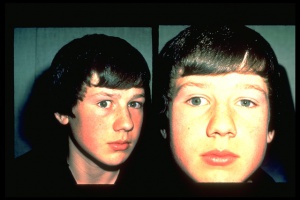Ocular Torticollis: Difference between revisions
Kara.Cavuoto (talk | contribs) No edit summary |
Kara.Cavuoto (talk | contribs) No edit summary |
||
| Line 14: | Line 14: | ||
[[File:Congenital left fourth nerve palsy.jpg|thumb|Congenital left fourth nerve palsy. A, Note the left hypertropia and right head tilt as a child. B, Forty years later, the right head tilt is still present, but the patient describes more difficulty maintaining single, binocular vision. C, After eye muscle surgery, the diplopia and head tilt have resolved. Courtesy of Lanning B. Kline, MD. American Academy of Ophthalmology Image bank. https://www.aao.org/image/fourth-nerve-palsy-2]] | [[File:Congenital left fourth nerve palsy.jpg|thumb|Congenital left fourth nerve palsy. A, Note the left hypertropia and right head tilt as a child. B, Forty years later, the right head tilt is still present, but the patient describes more difficulty maintaining single, binocular vision. C, After eye muscle surgery, the diplopia and head tilt have resolved. Courtesy of Lanning B. Kline, MD. American Academy of Ophthalmology Image bank. https://www.aao.org/image/fourth-nerve-palsy-2]] | ||
Ocular torticollis is an abnormal head posture adopted in order to optimize vision and/or maintain binocularity. The incidence is approximately 3% in a pediatric ophthalmology practice.<ref Boricean ID, Bărar A. Understanding ocular torticollis in children. Oftalmologia. 2011;55(1):10-26.</ref> | Ocular torticollis is an abnormal head posture adopted in order to optimize vision and/or maintain binocularity. The incidence is approximately 3% in a pediatric ophthalmology practice.<ref name= Boricean ID, Bărar A. Understanding ocular torticollis in children. Oftalmologia. 2011;55(1):10-26.</ref> | ||
Ocular torticollis is an abnormal head posture adopted by a patient in order to maintain optimized and binocular vision. Head posturing may present as any combination of head tilt, face turn, chin elevation or chin depression.<ref name=":0">Mitchell PR. Ocular torticollis. Trans Am Ophthalmol Soc. 97, 697–769 (1999).</ref> Torticollis comes from the Latin word torti, meaning twisted, and collis, meaning neck.<ref name=":1">Wright KW, Strube YNJ. Torticollis, Nystagmus, and Incomitant Strabismus. Color Atlast of Strabismus Surgery. 35–40 (2015).</ref> | Ocular torticollis is an abnormal head posture adopted by a patient in order to maintain optimized and binocular vision. Head posturing may present as any combination of head tilt, face turn, chin elevation or chin depression.<ref name=":0">Mitchell PR. Ocular torticollis. Trans Am Ophthalmol Soc. 97, 697–769 (1999).</ref> Torticollis comes from the Latin word torti, meaning twisted, and collis, meaning neck.<ref name=":1">Wright KW, Strube YNJ. Torticollis, Nystagmus, and Incomitant Strabismus. Color Atlast of Strabismus Surgery. 35–40 (2015).</ref> | ||
Revision as of 11:39, March 14, 2021
All content on Eyewiki is protected by copyright law and the Terms of Service. This content may not be reproduced, copied, or put into any artificial intelligence program, including large language and generative AI models, without permission from the Academy.

Ocular torticollis is defined by abnormal head posture as a compensatory mechanism for an ocular abnormality.
Overview

Ocular torticollis is an abnormal head posture adopted in order to optimize vision and/or maintain binocularity. The incidence is approximately 3% in a pediatric ophthalmology practice.Cite error: Invalid <ref> tag; invalid names, e.g. too many Torticollis comes from the Latin word torti, meaning twisted, and collis, meaning neck.[1]
Ocular torticollis can be classified into two groups: an attempt to improve visual resolution or a compensatory response for muscle imbalance. The first group consists of individuals with oblique axis astigmatism, nystagmus/spasmus nutans, or bilateral ptosis, who adopt abnormal head posture to optimize visual resolution.[2] The second group includes individuals with extraocular muscle weakness or paresis who adopt abnormal head posture to optimize binocularity. This group typically presents with an incomitant strabismus, defined by asymmetric deviation of the eyes with changes in the gaze angle.[3]
A prospective study of 188 patients with ocular torticollis identified the most common etiologies: 62.7% of the cases were due to incomitance and 20.2% due to nystagmus.[4] A/V pattern horizontal incomitance leading to incomitant strabismus was found to be the most common cause of ocular torticollis.
Incomitant strabismus means the eyes are not moving in synchrony, which may be a result of extraocular muscle restriction, paresis, or overaction. The head tilt, face turn, or chin positioning would compensate in order to achieve binocular vision. For instance, a tight medial rectus muscle in the right eye will produce an esotropia in right gaze and provoke a face turn to the right to keep the eyes aligned in left gaze.[1]
Patients with nystagmus will often have a gaze angle that minimizes the magnitude of ocular movements. This position is defined as the null point or null zone.[1] If the null point is eccentric to the primary position, the patient may adopt a compensatory head posture to align the eyes at the null point, dampening the nystagmus and improving vision. This face positioning may be face turn, chin elevation/depression, head tilt, or a combination.[1]
While ocular torticollis may occur at any age, it typically manifests later than musculoskeletal torticollis. This is because binocular vision development initiates at 4 months of age, peaks at 2 years, and is well developed by 4 years of age.[5]
Etiology
The etiology of torticollis in general may be orthopedic, neurologic, or ocular. Orthopedic etiologies include acquired traumatic or inflammatory myositis, congenital musculoskeletal abnormalities, fibrotic shortening of the sternocleidomastoid muscle, Klippel-Feil syndrome, and occipito-cervical stenosis. Neurologic etiologies include cervical spine subluxation, abnormalities of the skull such as plagiocephaly or coronal suture stenosis, or hiatal hernia. Torticollis may also be associated with asymmetric deafness or psychiatric disturbances.[4]
Ocular etiologies include ocular muscle imbalance typically presenting as various types of incomitance (e.g. extraocular muscle palsy/paresis), oblique axis astigmatism, nystagmus/spasmus nutans, or bilateral ptosis, or a combination of multiple causes.[2]
Differential Diagnosis[4][6]
- Attempt to improve visual resolution
- Oblique axis astigmatism
- Nystagmus
- Infantile nystagmus syndrome (congenital motor or sensory nystagmus; null point)
- Fusion maldevelopment nystagmus syndrome (manifest latent nystagmus; less in adduction)
- Periodic alternative nystagmus (alternating null point)
- Spasmus nutans
- Acquired adult jerk nystagmus
- Bilateral ptosis
- Monocular blindness (with fusion maldevelopment nystagmus syndrome, or for centration of remaining field)
- Refractive error
- Ocular muscle imbalance
- A- or V- pattern esotropia or exotropia
- Paretic strabismus
- Superior oblique palsy
- Duane retraction syndrome
- Sixth nerve palsy
- Third nerve palsy
- Inferior oblique palsy
- Restrictive strabismus
- Brown syndrome
- Thyroid eye disease
- Orbital fracture
- Congenital fibrosis of extraocular muscles
- Dissociated vertical deviation
- Ocular tilt reaction
- Homonymous hemianopia
- Non-ocular causes
- Orthopedic
- Traumatic or inflammatory myositis
- Congenital musculoskeletal abnormalities
- Fibrotic shortening of the sternocleidomastoid muscle
- Klippel-Feil syndrome
- Occipito-cervical stenosis
- Neurologic
- Cervical spine subluxation
- Plagiocephaly
- Coronal suture stenosis
- Asymmetric deafness
- Supranuclear disorders
- Monocular elevation deficiency=
- Dorsal midbrain syndrome
- Gaze palsy
- Psychiatric disturbance
- Orthopedic
Diagnosis
Ocular torticollis is diagnosed primarily by history and clinical exam. Diagnostic evaluation may include measuring the abnormal head position, evaluating extraocular motility and alignment with particular attention to gaze positions opposite to those favored, external examination for nystagmus and ptosis, and retinoscopy to assess refractive error with particular attention to oblique axis astigmatism. Subtle nystagmus may be visible only during slit-lamp or fundus examination.[6] A dilated fundus examination may also be helpful for evaluating torsional misalignment. Hess-Lancaster or a Lee screen may be used to asses for antagonist muscle contracture. Stereoscopic tests and prisms to test for motor fusion may also be used. The Bielschowsky three step test can be performed to diagnose superior oblique palsy. The alternate occlusion test can identify an ocular muscle imbalance by eye occlusion.[2]
Epidemiology
A 2-year prospective study of abnormal head postures with ocular etiologies was analyzed by Kushner in 1979 and identified incomitance as the leading cause of ocular torticollis.[7] Mitchel et al. confirmed incomitance as the leading cause with an expanded prospective study published in 1999.[4]
The Kushner study identified eight basic mechanisms causing ocular torticollis in a study group of 188 patients from an academic center. Out of the 188 cases, 118 (62.7%) were related to incomitance, 38 (20.2%) were due to nystagmus, 12 (6.3%) due to congenital esotropia with ocular posture, 10 (5.3%) due to permitting foveal fixation, 4 (2.1%) with cosmetic etiology, 3 (1.6%) due to ocular motor apraxia, 2 (1%) with spasmus nutans, and 1 (0.5%) with astigmatism.[7]
Mitchel studied a group of 630 patients from a private ophthalmology practice and analyzed the etiologies of ocular torticollis; he further differentiated ocular torticollis secondary to incomitance into specific causes. Out of the 630 cases of ocular torticollis, 330 (52.4%) were related to incomitance, 120 (19%) were due to nystagmus, 69 (10.9%) due to congenital esotropia with ocular posture, 27 (4.3%) due to permitting foveal fixation, 2 (0.3%) due to spasmus nutans, 57 (9%) without an identified etiology, and 25 (4%) associated with medical or neurologic conditions. Among the 330 cases of ocular torticollis related to incomitance, 116 (35.2%) were due to A/V pattern horizontal incomitance, 59 (17.9%) were due to superior oblique palsy, 48 (14.5%) were due to horizontal incomitance from asymmetric surgery, 46 (13.9%) were due to Duane syndrome, 25 (7.6%) were due to Brown syndrome, 9 (2.7%) were due to double elevator palsy, 6 (1.5%) were due to inferior oblique palsy, 4 (1.2%) were due to torsional incomitance, 1 (0.3%) was due to sixth nerve palsy, 1 (0.3%) was due to third nerve palsy, and 1 (0.3%) was due to superior rectus palsy.[4]
Management
Management is directed towards treating the etiology of ocular torticollis. In the setting of an incomitant strabismus, the strategy is to surgically correct the eye misalignment to primary position in order to increase the field of binocular fusion and decrease the face turn. In patients with normal or minimally limited extraocular motility, surgery is typically performed on both eyes. If there is significant unilateral oculomotor restriction or palsy, the face turn may be corrected by moving the eye with limited motility into primary position.[1] In the setting of nystagmus, the strategy is to identify the fixating eye and null point as these two components determine the magnitude of face turn. Surgery then involves moving the null point of the fixating eye to the primary position, and then correcting any residual or induced strabismus by repositioning the non-fixating eye.[1] Early diagnosis and correction of underlying ocular etiology of torticollis is important to prevent development of musculoskeletal changes such as neck and facial asymmetry.[6]
References
- ↑ Jump up to: 1.0 1.1 1.2 1.3 1.4 1.5 Wright KW, Strube YNJ. Torticollis, Nystagmus, and Incomitant Strabismus. Color Atlast of Strabismus Surgery. 35–40 (2015).
- ↑ Jump up to: 2.0 2.1 2.2 Campos EC. Ocular torticollis. Int Ophthalmol. 6(1), 49–53 (1983).
- ↑ Adams DL, Economides JR, Horton JC. Incomitance and Eye Dominance in Intermittent Exotropia. Invest Ophthalmol Vis Sci. 58(10), 4049–4055 (2017)
- ↑ Jump up to: 4.0 4.1 4.2 4.3 4.4 Cite error: Invalid
<ref>tag; no text was provided for refs named:0 - ↑ Bhola R. Binocular vision. Eyerounds.org. 23 January 2006. <http://eyerounds.org/tutorials/Bhola-BinocularVision.htm>.
- ↑ Jump up to: 6.0 6.1 6.2 American Academy of Ophthalmology. “Torticollis: Differential Diagnosis and Evaluation.” Basic and Clinical Science Course: 2017 - 2018, 77–78 (2017).
- ↑ Jump up to: 7.0 7.1 Kushner BJ. Ocular causes of abnormal head postures. Ophthalmology. 86(12), 2115-25 (1979).

